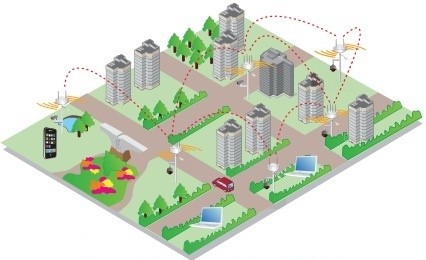5G technology will create a new ecosystem that will extend beyond the typical voice and mobile data services of existing technologies like 2G, 3G, and LTE. Thus, with massive device connectivity, sensors, and IoT, a 5G system is expected to have a much broader sense than just 5G New Radio.
A new such area of 5G development is campus networks. 5G Campus networks can be defined as the enhanced connectivity solutions for a specific local area, tailored to the needs of the enterprises, enterprise users, and the relevant use cases.
Campus Networks history
Enterprise Networks were already proposed in the 3G/LTE era and with WiFi connectivity. However, they had limited success due to the scarce spectrum and poor data performance.
On the contrary, 3GPP 5G NR networks provide extremely high throughput and over-perform existing technologies in other areas such as latency and massive connectivity. Higher spectrum in the millimeter-wave bands is ideal for indoor deployments since WLAN does not seem to meet any longer the customer reliability requirements.
Campus networks can generally use licensed, unlicensed, or shared spectrum. It is also possible to use the Citizens Broadband Radio Service (CBRS), a 150 MHz wide broadcast band of the 3.5 GHz spectrum in the US and the Regional spectrum in the EU.
Campus Networks and 5G
Campus networks can offer a first 5G-like experience that is tailored to specific network requirements high throughput, low latency, reliability, security, and IoT support, similar to 5G systems.
A campus network orchestrates different areas of applications and provides optimized connectivity. A dedicated system can be developed with high-security levels to connect local units in real time and provide enhanced Quality of Service.
The added value of a 5G wireless architecture in campus networks compared to other connectivity technologies such as fiber has also to be considered. With 5G wireless infrastructure, the costs of cabling installation and maintenance will be removed. The time needed to reconfigure the network will be reduced since a single company network will be deployed for all kinds of industrial applications and communication. The existing infrastructure will be able to integrate directly mobile devices and various users. There is also the option to build a wireless overlay network for comprehensive production monitoring, SCM, and asset management.
5G Campus Networks and other technologies
The advantages of a 5G network compared to existing LTE technology, as mentioned above, are the ultra-low latency, the higher overall throughput, but also the inherent security by dedicated network slices.
Compared to WiFi technology, a 5G campus network can be managed within a licensed spectrum framework, with fewer access points, better indoor penetration, and optimized support of mobile use cases via the base station handover.
5G Campus Networks Benefits
Coverage & connectivity:
With 5G networks, the system can reach as many devices as possible and can expand connectivity from 5G mobile devices to industrial devices and various different users. Additional cells can be incorporated, such as onsite, indoor, outdoor, small cells, and the cell splits. Multiple access technologies can be supported, such as Distributed antenna systems (passive, active), Beamforming, and MIMO to complement coverage.
Capacity and bandwidth:
In 5G technology, more spectrum is available to enhance the overall network capacity. New 5G spectrum at 3.5GHz (100MHz) and > 6GHz is available. This is assisted by the full deployment of main LTE bands at 800MHz, 2.6GHz, refarming of GSM/UMTS bands 900MHz, 1800MHZ, 2.1GHz and with the use of unlicensed spectrum (WLAN, LAA, LTE-U) with Carrier Aggregation techniques.
Latency:
5G latency improvements will decrease the round trip time (RTT) through the overall network. The traffic can be physically kept on campus locally, which will provide the shortest possible rerouting of traffic and avoid transmission delays.
Traffic Separation and Prioritization:
The campus traffic can be separated from the 5G public traffic or prioritized if resources are shared. Physical resources can be allocated in their own dedicated network, or have dedicated spectrum and/or a dedicated small cell layer for campus traffic. VPNs or APNs can also be used, together with QoS mechanisms or logically separated networks via Network Slicing.
High Reliability:
The system can ensure continuous availability of the campus network and be able to mitigate effects from failures and downtimes. Different devices can be combined via multi-path TCP, or different cells could serve a single device via hierarchical cell layers, dual connectivity, and COMP.
Manageability:
The system can also assure the ease of the supervision and administration of a campus network. A dashboard can be used to visualize the network and device status, while probes / Apps to supervise SLAs and the granted connectivity level and APIs into the public network to administer the campus slice.
Security and Privacy:
Firewalls and Intrusion Detection Systems can be used to maintain the campus network integrity, while campus network data could also be encrypted. Dedicated nodes, rather than shared systems, can be used to keep traffic and data locally on campus.
5G Campus Networks investment
Mobile Operators are planning to start investing in 5G from specific areas such as city urban environments and then gradually expand their 5G network penetration, since a massive nationwide rollout of 5G may be too expensive for early deployment.
Campus networks are local areas, which makes them ideal for limited and controlled investments. In that way, the tests, PoCs, and commercialization of the 5G capabilities regarding latency, bandwidth, and capacity for campus networks will not have a significant impact on the nationwide LTE and 5G network implementation.
Furthermore, no mass market terminals are needed initially, as in the case of 5G NR, but rather smart industrial devices, with early availability which favor scalable investment. All of the above, make 5G campus networks an attractive solution and one of the prime candidates for creating a new 5G ecosystem beyond the typical use cases of existing technologies.













